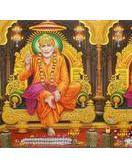Maya: cómo la Física Cuántica explica lo que fue escrito y comprendido por nuestros antiguos sabios hace muchos millones de años. Por lo tanto, la ciencia no material ahora solo reconoce lo que nuestros antiguos sabios sabían sobre la realidad hace millones de años. La palabra maya es una palabra muy familiar para el mundo occidental y oriental, pero muy pocos saben lo que realmente significa. Es una palabra que fue utilizada por los rishis (sabios) de la antigua India para describir la naturaleza de este universo de formas cambiantes. Los rishis siempre nos han dicho que la materia no es tan real ni tan sólida como pensamos. Es solo una ilusión proyectada por nuestros sentidos. Lo llamaron "maya" o el mágico poder creativo del "Brahman".
LO QUE SRI SATHYA SAI TIENE QUE DECIR SOBRE MAYA Swami, ¿qué es esta Maya [ilusión, supuestamente creada por Dios]? Maya no existe; es toda la imaginación de uno. Pensar que eres el cuerpo es Maya. Cree erróneamente que es algo [cuerpo] que en realidad no es; esa es Maya. En verdad, no existe Maya; es toda la imaginación de uno. Maya es como la sombra de un árbol. ¿Qué proyecta la sombra? Las ramas del árbol y no los rayos del sol. Si no hay ramas, tampoco hay sombra. La sombra llamada Maya surge de las ramas llamadas deseos humanos. Si no hay deseos, ¡tampoco hay Maya! FIN DE LA CITA
La materia es energía en movimiento Con los albores del siglo XX, encontramos que la física comenzó a respaldar este punto de vista. Con un garabato de su pluma, Einstein hizo estallar la visión determinista y mecánica de la materia - E = MC² - "La materia es energía en movimiento". Esto creó una revolución en la mente de los científicos occidentales. La teoría de la relatividad nos mostró que solo podemos conocer las relaciones entre objetos, y la teoría cuántica declaró que solo podemos ver probabilidades. Lo que consideramos materia sólida es una ilusión creada por nuestros ojos. De hecho, es la "maya" de la que hablaban los rishis. En realidad, la materia está formada por partículas y ondas que simplemente indican los diferentes tipos de conocimiento que pueden derivarse de ese objeto. Por lo tanto, ¡la física moderna se ocupa de posibilidades o probabilidades y no de certezas! Los científicos finalmente se dieron cuenta de que nuestros sentidos no nos dan una imagen real de la realidad. Esto es exactamente lo que los rishis de la antigua India nos habían estado diciendo hace más de cinco mil años.
Observación y una etapa sólida Maya es ese estado en el que la mente confunde la miríada de formas del mundo y las toma como reales sin aprehender la unidad subyacente que las une a todas. Lo que le da forma y propósito al drama que disfrutamos en la televisión es la pantalla firme, inmutable y en blanco puro que se encuentra debajo. La pantalla en sí no tiene cualidades. Es inmóvil e inmutable, pero sin este soporte sólido, el juego de luces y sombras que estamos viendo no tendría forma ni significado. De manera similar, el drama de nuestra vida y el drama del mundo que tiene lugar frente a nuestros ojos no tendrían sentido sin la etapa sólida del estado estable e inmutable de la Conciencia Pura del Brahman en el que se está representando. El mundo cuántico, que es una danza extraña e increíble de partículas, se solidifica en una apariencia de realidad concreta cuando alguien hace una observación. En ausencia de un observador, el mundo atómico es solo una posibilidad. Las partículas se materializan solo cuando las buscamos. Otro hecho extraño es que cuando los científicos buscaron la ubicación de una partícula pudieron encontrarla en un lugar en particular, pero no pudieron medir su velocidad. Cuando quisieron medir su velocidad, la partícula se convirtió en una onda y pudieron verla en movimiento. Sin embargo, el científico no pudo fijar tanto su ubicación como su velocidad al mismo tiempo. ¡Ambos dependían del observador! No podemos observar una cosa sin influir en ella. Esto nos lleva de regreso a la verdad que habían declarado los rishis: que cada uno de nosotros realmente está creando nuestro propio mundo. La ciencia moderna ha corroborado las afirmaciones de los rishis de que este es en realidad un mundo de sombras, que solo puede llamarse real cuando entra en juego la conciencia del observador. Normalmente, las partículas cuánticas actúan al azar de caos y desorden; pero cuando la conciencia individual se centra en ellos, pierden su individualidad y comienzan a actuar como una sola unidad. Esta coherencia se extiende al mundo. Por tanto, la conciencia humana representa la forma más grande de orden conocida en la naturaleza y puede ayudar a moldear y crear orden en el mundo. En la meditación, y especialmente en el estado de "Samadhi" (un estado superconsciente), el cerebro toca el campo de punto cero de la física cuántica, que se conoce como chitta en sánscrito, en cuyo estado el cerebro tiene una coherencia perfecta. Lo vital aquí es la participación del individuo. La teoría clásica afirmó que el observador es el único
WHAT IS MAYA AS UNDERSTOOD BY SAGES AND SCIENTISTS NOW DECODED WITH HELP OF QUANTUM PHYSICS. WRITTEN BY BATTULA VINAY KUMAR AND DR M VANAMALLI
Maya: how Quantum Physics explains what is and was written and understood by our Ancient sages many millions of years ago. Thus Non Material Science now only acknowledges What our Ancient Sages Knew About Reality millions of years ago. The word Maya is a word which is very familiar to the western and eastern world, but very few know what it actually means. It is a word which was used by the rishis (sages) of ancient India to describe the nature of this universe of changing forms. The rishis have always been telling us that matter is not as real or as solid as we think. It is only an illusion projected by our senses. They called It "maya" or the magical creative power of the "Brahman".
WHAT SRI SATHYA SAI HAS TO SAY ABOUT MAYA Swami, what is this Maya [illusion, supposed to be created by God]? There is no such thing as Maya; it is all one's imagination. To think that you are the body is Maya. You mistakenly believe that you are something [body] that you really are not; that is Maya. Truly speaking, there is no Maya; it is all one's imagination. Maya is like the shadow of a tree. What casts the shadow? The branches of the tree and not the rays of the Sun. If there are no branches, there is also no shadow. The shadow called Maya arises from the branches called human desires. If there are no desires, then there is no Maya as well! END OF QUOTE
Matter is Energy in Motion With the dawn of the 20th century, we find that physics started to support this view. With one squiggle of his pen, Einstein exploded the deterministic, mechanical view of matter - E=MC² - "Matter is energy in motion." This created a revolution in the mind of western scientists. The theory of relativity showed us that we can only know the relations between objects, and quantum theory declared that we can only see probabilities. What we think of as solid matter is an illusion created by our eyes. In fact, it is the "maya" which the rishis talked about. Matter is actually made up of particles and waves that merely indicate the different types of knowledge that can be derived from that object. Therefore, modern physics deals with possibilities or probabilities and not with certainties! Scientists finally realized that our senses do not give us a true picture of Reality. This is exactly what the rishis of ancient India had been telling us more than five thousand years ago.
Observation and a Solid Stage Maya is that state when the mind confuses the myriad forms of the world and takes them for real without apprehending the underlying unity that binds them all together. What gives form and purpose to the drama we enjoy on the TV is the firm, unchanging, pure white screen beneath. The screen itself has no qualities. It is unmoving and unchanging, but without this solid support, the play of light and shade which we are watching would have no form and no meaning. Similarly, the drama of our life and the drama of the world taking place in front of our eyes would have no meaning without the solid stage of the steady, unchanging state of the Pure Consciousness of the Brahman on which it is being enacted. The quantum world, which is a strange, unbelievable dance of particles, solidifies into a semblance of concrete reality when an observation is made by someone. In the absence of an observer, the atomic world is only a possibility. The particles materialize only when we look for them. Another strange fact is that when scientists looked for the location of a particle they were able to find it at a particular place, but they could not gauge its speed. When they wanted to gauge its speed, the particle turns into a wave and they could see it in motion. However, the scientist could not fix both its location and speed at the same time. Both depended on the observer! We cannot observe a thing without influencing it. This takes us back to the truth which had been declared by the rishis: that each of us is really creating our own world. Modern science has corroborated the statements of the rishis that this is actually a shadow world, which can be called real only when the consciousness of the observer comes into play. Normally quantum particles act in a haphazard fashion of chaos and disorder; but when individual consciousness is focused on them, they lose their individuality and begin to act as a single unit. This coherence extends into the world. Thus, human consciousness represents the greatest form of order known in nature and can help to shape and create order in the world. In meditation, and especially in the state of " Samadhi" (a super conscious state), the brain touches the zero point field of quantum physics, which is known as the chitta in Sanskrit, in which state the brain has perfect coherence. The vital thing here is the participation of the individual. Classical theory asserted that the observer is the one. FUENTE: http://www.sathyasaibababrotherhood.org/ssbb.htm
Sathya Sai Baba Brotherhood: Welcome About Sai Baba's Brotherhood; Swami's youth, life, projects. www.sathyasaibababrotherhood.org


